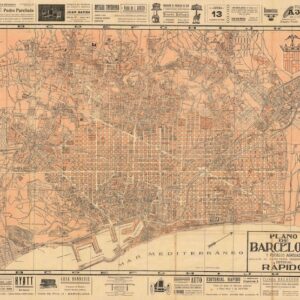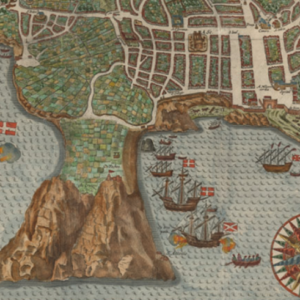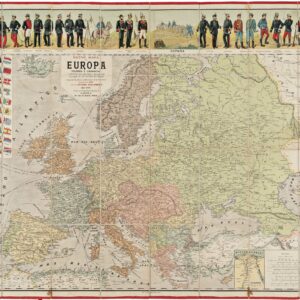An exceptional WWI Era Map of the Western Front, just months before the German Kaiser’s final surrender.
The Literary Digest Liberty Map of the Western Front of the Great World War.
$375
In stock
Description
All Hell on the Western Front.
Immerse yourself in the grandeur and detail of this original WWI era map, spanning an impressive 51 x 42 inches (131 x 107 cm) and depicting a major theatre of the War. This meticulously crafted cartographic snapshot of the Western Front was engraved and printed by the renowned Matthews-Northrup Works in Buffalo, a prominent printing company in the early 20th century, and subsequently published by the equally famous and esteemed publishing house Funk & Wagnalls Co.
The map depicts the Western Front as it stood on October 1st, 1918, or 1 month and ten days before the end. It originally accompanied The Literary Digest magazine as an independent supplement. Our map is, in fact, one in a series of such maps showing how the horrific war in the trenches of the Western Front progressed in the final months of the war. While many of these editions appear identical, they include the subtle distinctions created when tracking infantry positions along an extended line. While our example specifically displays the situation on October 1st, 1918, we have seen other editions that show the front lines as they stood in May, June, August, and September. The war formally ended on November 11th, 1918, and we must assume that our example of this map was published either shortly before or just after peace was won.
The Literary Digest Liberty Map of the Western Front depicts the battle lines and denotes the farthest extent of military invasion into both German and Allied territory. The main battle line on our map has been drawn in as it stood on October 1st. This is marked out by the tricolore of a thick and continuous blue, white, and red line. A thick red line marks the farthest extent of the German Army in 1918, whereas the respective armies’ most advanced positions early in the war (1914) are marked in dashed lines: red for the German positions and blue for the French.
The maps focussed on the western front, with the scope of the main map not exceeding far beyond southern England and Holland in the north and the Alsatian front in the southeast. An inset in the lower left corner nevertheless provides both a broader geographic overview and context. This shows the entire war arena in Europe but also includes large parts of Northern Africa, Russia, and the Levant. These regions have been included not only to show the enormous scope of the conflict but also to highlight some of the more obscure campaigns in the Balkans, Italy, Palestine, Mesopotamia, and Tsarist Russia. A most interesting feature of this inset is that it also demarcates the zones of submarine blockade (e.g. around the Iberian Peninsula and Denmark), which would turn out to be a crucial strategic element in disrupting supply lines and thus winning the war.
A second inset in the top right corner of the map relays essential economic data on the production of pig iron in metric tons and coal in short tons (pig iron is the core ingredient needed to produce steel). The inclusion of these numbers on a war map designed for mass popular consumption reflects just how important industry and industrial resources were in the unfolding of World War I and underscores how the great powers of the future will have to harness such production capacity if they want to maintain their dominant positions.
As one admires the intricate details of this map, it becomes evident that it is not merely a geographical representation but rather a profound artifact that bears witness to the bloodshed and the triumphs, the losses and the gains of this great conflict. Owning it is akin to possessing a piece of living history. It constitutes a tangible reminder of the courage and determination that characterized a generation of brave young men, who, despite being removed from it in the most violent fashions, came to shape our world. It is a bridge that connects us with our past and a way of honoring those who secured the liberties we enjoy today at the price of their own lives.
Cartographer(s):
Funk & Wagnalls Company was a prominent American publishing house known for producing dictionaries, encyclopedias, and other reference works. The company was founded by Isaac Kaufmann Funk and Adam Willis Wagnalls in 1875.
Matthews, Northrup & Co.Matthews, Northrup & Co. was a prominent American printing and publishing company based in Buffalo, New York. It operated during the late 19th and early 20th centuries and was known for producing high-quality illustrations, maps, and other printed materials.
The company was founded in 1873 by Edward Amherst Ott, Frederick W. Matthews, and George G. Herendeen. Initially named “Matthews & Northrup,” the firm focused on bookbinding and printing. In 1877, the company changed its name to “Matthews, Northrup & Co.” after William H. Northrup, a talented engraver and lithographer, joined as a partner.
Matthews, Northrup & Co. quickly gained a reputation for its excellence in printing and innovative use of lithography, a printing method that allowed for detailed and colorful illustrations. The company specialized in producing a wide range of products, including atlases, maps, travel guides, and promotional materials.
One of the most significant contributions of Matthews, Northrup & Co. was its involvement in the production of “The Encyclopaedia Britannica.” In the late 19th century, the company secured a contract to print the ninth edition of the encyclopedia, which was a monumental undertaking at the time.
Condition Description
Very good. Some wear and foxing along edge.
References




